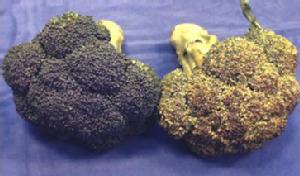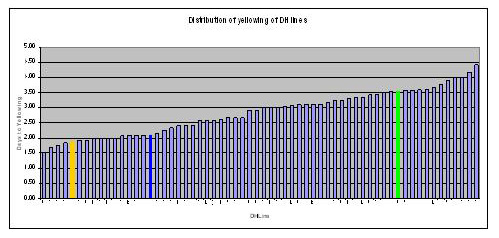Genetics and genomics of post harvest senescence in broccoli
Broccoli is a popular green vegetable that provides a useful component of a healthy diet due to a high content of vitamins, minerals and beneficial compounds such as antioxidants, flavonoids and glucosinolates.
Loss of quality of green vegetables after harvest is manifested by rapid deterioration in appearance accompanied by loss in flavour and nutrient value. We are examining the relative effects of environmental conditions and genotype on the shelf life of Brassica vegetables such as broccoli. Broccoli is a major vegetable brassica crop world-wide. In the UK, the demand for fresh broccoli has increased significantly over the last 10 years. However, broccoli has a notoriously short shelf life and the lack of predictability in post harvest performance causes the major retailers to specify a product ‘shelf-life’ of only two days, with a further two days to ‘best consumed by’ in an attempt to ensure a quality product to the consumer. Loss of quality of harvested heads is due to yellowing of the buds and/or loss of turgor resulting in ‘wilted’ heads. Poor post harvest performance results in significant waste to the retailer and consumer.

We are using post harvest yellowing in broccoli to identify genes involved in controlling the shelf life of green vegetables.
Many genes similar to those expressed in leaf senescence are also upregulated in broccoli post harvest yellowing indicating that many similar processes are taking place.
Projects:
- Predicting the shelf life of field grown vegetables
- Genetic mapping of QTL involved with time to yellowing on storage
A microarray carrying 2 500 broccoli head cDNAs has been generated to identify genes that could act as markers to predict the shelf life time of a broccoli crop.
Shelf life of broccoli is affected strongly by environmental factors such as drought stress which results in very variable quality.
Shelf life of broccoli is also controlled at the genetic level and we are exploiting this to identify QTL and genes that are linked to quality traits such as post harvest yellowing, turgor etc.
We have generated a doubled haploid mapping population from two broccoli parents that show a very different time to yellowing. The members of the mapping population show a wide variation in shelf life and several significant QTL have been mapped for this trait, and a population of backcross inbred lines have been created.
Examples of six members of the mapping population after 3 days of storage.

The range of times to yellowing in the mapping population, the good parent is shown in green, the poor parent in yellow and the F1 from the cross in blue.

We used this population to characterise morphological traits relating to head architecture and leaf shape:
Walley, P. G., Carder, J., Skipper, E., Mathas, E., Lynn, J., Pink, D., Buchanan-Wollaston, V. (2012) A new broccoli x broccoli immortal mapping population and framework genetic map: tools for breeders and complex trait analysis. Theoretical And Applied Genetics, 124: 467 - 484.Link opens in a new window
This mapping population is being expanded and will be used to map QTL for other traits such as nutrient levels. For a review of the health promoting properties of the brassicas see:
Walley, P. G. and Buchanan-Wollaston, V. (2011) 'Brassicas' in Health promoting properties of fruit and vegetablesLink opens in a new window, Editors: Terry, L., CABI.
We have created a new panel of KASPar SNP markers, these have been used to genotype the population. The markers were also used to genotype BC1 DH lines. The new data for the population is being used to make a new linkage map. This map is being integrated with new KASPar linkage maps for the AGDH and TBDH mapping populations.
Vicky Buchanan-Wollaston
David Pink
Peter G. Walley
Emma Skipper
John Carder

